The main factors that determine the climate of the tundra are high latitudes with their characteristic atmospheric circulation, proximity to the Arctic and flat relief.
The climate of the tundra is characterized by long and cold winters, short summers, scarcity atmospheric precipitation, large clouds and strong winds. average temperature the warmest month does not exceed 10-12 °, but not lower than 0 °. Relative humidity does not fall below 70% on average at 1 pm.
Even the presence of a yellow ballerina is associated with the presence of running water. 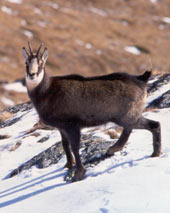
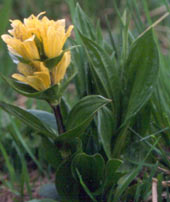
In the summer, the Alpine prairies are full of life. Flowers and animals look like nothing goes away once the snow melts. The marmot emerges from deep meadows where it hibernated, returns from the forest where it found food, a culinary, small migratory bird, back from Africa where it hibernated.
With some luck, you may encounter an ermine that runs among the rocks with its favorite prey: a hail of snow, while it is more difficult to see the alternating hare, the day is always hidden to evade the spotlight, a real eagle flies over the prairie. Due to changes the environment With the abandonment of traditional mountain activities, it is becoming increasingly difficult to see the Koturny moving along the sunny slopes.
The characteristic features of the tundra climate, in addition to its general severity, are also the predominance of monsoon winds, insignificant evaporation, uneven snow cover and an exceptional maximum stress. solar radiation(in a cloudless time).
Arctic air is predominant for the tundra. The air temperature is low all year round. The average annual does not exceed + 1 °, the lack of air saturation with moisture at low temperatures is small, evaporation is low and precipitation, therefore, is insignificant (on average 200-300 mm per year, and only in Murman up to 350 mm).
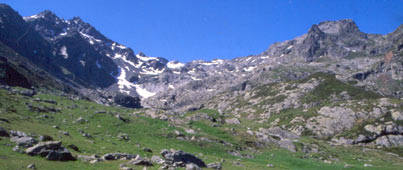
Life at high altitudes is more difficult for cold-blooded animals, so the black salamander and lizard living to reproduce have adopted the same reproductive strategy: instead of laying eggs like most amphibians and reptiles, keep the eggs in your body, which provides the heat needed to hatch, and thus give birth to a small light, already able to move in search of food.
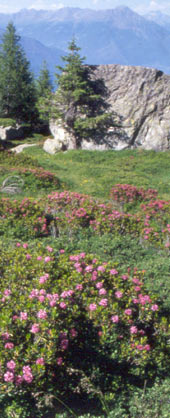
Rhododendron prefers moist and shady slopes opposite the juniper, which settles on arid and well-exposed slopes. In conditions of high humidity both in the air and in the soil, the vegetation of green alder, accompanied in the eastern central valleys of the park from the endemic species of Orobi.
The tundra is characterized by frequent and sharp fluctuations in temperature, which are very sensitive to humans at high relative humidity. The constantly large cloud cover in the tundra is explained not only by the low temperature of these latitudes, but also by the monsoon circulation: winds blowing from inside the continent in winter cool on their way to the Arctic, increasing cloud cover, and summer winds from the seas reach the tundra not yet warmed up and also increase cloud cover. The monsoon nature of the circulation is clearly expressed in the entire tundra zone.
Ontaneto is also pushed into the woodland along the avalanche channels. Less popular is pine, whose distribution is limited to a few stations in the Aprica and Val Gerola areas. The animal symbol of the transitional environments between forests and alpine prairies is undoubtedly a forked cock, a tetraonid with pronounced sexual dimorphism. The male is black and blue with a white undercut and red carnations on the eyes. The female has a plumage completely imitating, which especially protects it during hatching. In the spring, men find themselves in glades called chants for ritual battles that will allow the stronger to connect more women. Marshal, the most common viper in mountainous areas, which in these difficult conditions, as a rule, is ambushed by its prey.
The wind force in the tundra is high (5-6 m / s on average per year) due to the flat relief and the proximity to the ocean. The snow cover is uneven, as strong winds blow snow from place to place. The soil, poorly protected by snow cover, freezes strongly in winter, as a result - permafrost everywhere (excluding Kola Peninsula). However, on a polar day, a continuous flow of solar energy that warms up the earth and the air, an abundance of light ensure the rapid development of tundra vegetation, vegetating here for 2-2% of the month. The maximum voltage of direct solar radiation received by the tundra on a polar day is even greater than in southern regions THE USSR. So, on the lake. Imandra (68 ° N) the solar radiation intensity in July 1935 in the morning hours with a cloudless sky was 30% higher than in Evpatoria; in Kirovsk, the voltage value in June 1935 was 1.44 cal per minute per 1 sq. cm perpendicular surface, that is, more than in the Crimean resorts. However, due to the large cloudiness, the heat values of direct radiation in the tundra are small, while the scattered radiation is almost 40% of the total. Due to the large length of the tundra zone from west to east, its individual areas have significant climatic differences corresponding to certain climatic regions.

Applying it, one can observe some sparrows, such as a sitting sparrow or a jacket, and an organ, both red and white on the chest and on the forehead, which are well known for performing in characteristic canons. In summer, these environments are colored with vibrant colors of rhododendrons and colorful butterflies. 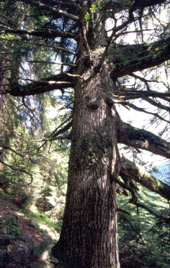
The most common conifer in Orobi is spruce or spruce, the forests of which are called subalpine peacocks and mountain peaks based on the distribution of height.
The tundras of the northwestern region are distinguished by an even distribution of temperatures, moderate winters (associated with the influence of the Gulf Stream and the passage of cyclones), significant rainfall, large clouds throughout the year and frequent fogs.
In terms of annual temperature, the northwestern tundra is the warmest. Here, such areas as Vaida-Guba and Murmansk have a positive average annual temperature. The strong influence of the Gulf Stream is felt almost to the Svyatonos lighthouse, to the east of which the influence of the eastern polar regions is already beginning to prevail. In Murman, January is on average warmer than on the northern coast of the Caspian Sea (Vaida Guba - 6 °, Astrakhan -9 °). Winter here captures November-March, spring April-May, summer June-August, autumn September-October. The temperature is distributed very evenly: in winter, on average - 10 °, in summer + 12 °. If not for the fjords and valleys that cut through the tundra and contribute to the stagnation of cold air in them, the temperature would not have dropped to -25 ° and lower in winter, although these temperatures are much higher than the minimum temperatures of the more eastern tundra. Annual amplitude here is almost the same as on Black sea coast Caucasus (18-20 °).
At high altitudes, spruce is accompanied or replaced by larch and only locally by pine. On the humid and shady slopes of the westernmost valleys of the park, spruce is associated with white spruce, and in sunny ones - pine, which can become dominant on steep slopes, with emerging stones.
The top of the coniferous forest, consisting of larch trees with rich undergrowth, on Orobah is a habitat for the selection of the pygmy owl, a tiny Boreo-Alpine nocturnal swell that exploits nesting cavities excavated by the great red woodpecker. Abyss, in spruce forests, an owl flies nest in nesting caves left by the black woodpecker, the largest of the European peaks. Spades and owls, but especially squirrels, must always be vigilant to avoid the attacks of the martyr, a skilled tree predator.
The direction of monsoon winds is strongly influenced by the local topography and coastal configuration: winds blow mostly along fjords and valleys, and only parts of the land that are most advanced in the sea (for example, Fishing peninsula) are characterized by the prevalence of general (westerly) winds. Both the monsoon nature of the wind and its diurnal variation are often disturbed by the passage of cyclones, especially frequent in February and October, when they are usually accompanied by blizzards and snowstorms. Precipitation falls more often in autumn (on average every other day); the smallest number of days with precipitation occurs in spring, when there is very little precipitation (less than 20% per annum). The intensity of precipitation is insignificant, showers are rare, more often drizzling. Snow falls here, although more often than in the more eastern tundra, but the thickness of the snow cover (60-70 cm), as well as the duration of occurrence (200 days), is less than in the east. Snow cover becomes stable in early October, although snow can fall any month; stable snow cover melts in June. Precipitation falls or does not fall in the tundra, the sky here is almost always gloomy, gray clouds seem to move quickly endlessly; only in early spring and on a polar day, several days with a clear sky are possible. The probability of a cloudy sky is at least 70%, and in the fall more than 90%. The relative humidity is naturally high when there is a lot of cloudiness, low air temperature, and frequent winds from the water surface; it is 80-90% in the cold part of the year and 65-75% in the warm half of the year. Fogs in the northwestern tundra are frequent (up to 59 foggy days a year), especially in summer. In winter, fogs occur mainly in wide bays, where they are associated with the passage over relatively warm, non-freezing waters of cold continental masses air.
Among those birds that are most suitable for hunting in the forest, there are squirrels and sparrows. Little sparrows rotate to look for food, different parts of conifers. The cruise is fed from above, pulling out Pine nuts from pine cones, with its skillfully adjustable beak; an alpine ramp looking for larvae on the trunk; rule of insects and spiders between foliage. Black cinnamon prefers to feed the ends of the branches, while the cliché from the bunch remains more hidden between the leaves.
Smaller and just as elusive is the Francolino Mountains, a close relative of the cedar that partly shares the habitat. During the breeding season, they need extensive clay rugs for feeding. 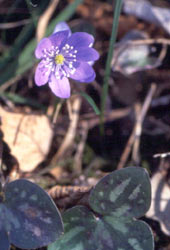
The arboreal essence that still dominates this vegetation group is the chestnut, the expansion of which was used in the past by a man who used fruits, woods and even as stables, leaves. The regular members of the beech are: mountain maple, bird sorcerers and white spruce. Blooming like this purple is focused on spring, before the leaves grow, reduces brightness in the underbrush.
The rivers of the northwestern tundra open up in the second half of May and freeze over in early November.
The tundra climate of the northeastern region is the most severe in Europe. It is characterized by a long period of negative temperatures, large fluctuations in climatological elements both in time and in space, and the presence of permafrost. The average annual temperature here is below zero (Pustozersk -4 °, 1).
The lower part of deciduous forests, where chestnut does not predominate, consists of oak, birch, ash and linden and, in high humidity, maple trees. The border between the two environments, which in ecology is called "ecotone", is usually an area of wealth biological species in which they live, in addition to species adapted to each of the two environments, as well as others that need this transition zone, for example, two birds of prey, one day, the noise that builds a nest in the trees and another night, an owl, nesting on rocky walls covered with woods, but using as for hunting in open areas.
The warm season (with temperatures above 0) begins on average around May 20 and ends in early October.
Although the duration of the warm season is 3% -4% of the month, the summer lasts only 1-1 1/2 months, the winter is long (about 200 days) and cold with significant snow cover (60-70 cm) ', thaws are rare.
The duration of the cold season (with an average daily temperature below 0 °) is 75-80 days longer than the warm one. The end of summer (the average daily temperature is above 10 °) comes around 15 August. Extreme temperature amplitudes can reach 80 °.
To take advantage of this ecological diversity, the common hare, roe deer, speed, faina and fox are also common. Regular patches and common owls divide the territory better, being the first, most typically in the forest, and the second, less and less often, hunting and nesting in open conditions.
Carving out deciduous forests in autumn, on rainy days, a strange black to yellow-spotted animal can be seen on the leafy carpet: this is the part of the salamander that uses its livery as a warning to possible predators. Of the 490 ecosystems assessed, for example, more than a third of terrestrial species and more than half of lake, river and coastal habitat species are threatened, according to Masaryk University.
The maximum temperatures are high here (30-33 °); however, their effect on the vegetation of the tundra is rather destructive than favorable, since the transpiration of moisture is delayed by the low temperature of the soil, and as a result, the phenomenon of opal occurs. Particularly low air temperatures in winter are noted in the area of the river. Sugor, where local geographic conditions contribute to this.
The Red List of Natural Habitats provides a new tool for managing the conservation and restoration of mainland Europe and the seas. Within the highest category of endangered habitat, four types of experts were included. These include, among others, the Pannonian steppe, whose former large area has shrunk as a result of afforestation, bush overgrowth and unnecessary nutrient enrichment.
Damage to drainage and transport infrastructure
“Large areas are still in national park Kiskunsag in Hungary, the last battered remains of this biotope in the Czech Republic are in Hodonin, ”said Chitri. Biologists appreciated natural environments habitat in 35 European countries, from the Arctic to the Mediterranean.
In the annual course, summer precipitation prevails, accounting for 60% annual quantity... Snow cover decreases very slowly, over 1 1/2-2 months; but on some days, at the moment of maximum melting, a layer of water of 5 mm is obtained. Such conditions contribute to the formation of spring floods. In the Pechora valley, snow lasts for a long time, sometimes until July, which is facilitated by sharp cold winds from the sea. In the coastal tundra, the winds are fastest especially in autumn, and also in winter, when they form a blizzard. The lowest speeds are observed during the height of summer. Due to the high relative humidity, which, like the temperature, has a large amplitude, the lack of saturation in winter is 0, and in the months with the lowest humidity, May-June, slightly exceeds 3 mm. Evaporation rate per year does not exceed 250 mm.
Pannonian sandy steppes are critical habitats. The former large area has been reduced to a fraction due to afforestation, shrubbery and unwanted nutrient fortification. Large areas survive in the Kiskunsag National Park in Hungary. In the Czech Republic, there are the last disturbed remains of this biotope on the sands of Hodonin.
These include, inter alia, the intensification of agricultural production, the abandonment of land traditionally harvested or cut for hay, drainage, pollution, the spread of non-native plant and animal species, and urban sprawl and industrial or transport infrastructure.
Permafrost has a great influence on the local climate. In the Bolshezemelskaya tundra, the thickness of the permafrost soil reaches 30 m. In the area of Pustozersk (Pechora delta), Shrenk found frozen ground, ranging from 1.4 to 19.2 m depth, followed by thawed soil.
The climate of the tundra of the West Siberian region is characterized by a sharp change in insolation throughout the year, long, cold, severe winters with frequent passage of cold waves, as well as cyclones, accompanied by strong storms and blizzards. The severity of the climate determines the preservation of permafrost and thawing of the soil in summer only from the surface.
At sea, major threats to nutrient fortification, overfishing and technical adjustments coastline... “Even the effects of current climate change are already reflected in terrestrial and marine ecosystems and are likely to manifest more and more,” Chitri added.
It manifests itself in the entire range of vegetation. Walter Forest Forest Classification. Tropical, evergreen forest... Tropical forest vegetation with summer rain. Subtropical, semi-arid and desert. Hardwood, hardy green vegetation with winter rain.
In the warm season, the sun does not fall below the horizon for about three months, in the cold season it does not rise above the horizon for about three months. The sum of summer heat is greater here than under the same latitudes to the west, but less than in the East Siberian tundra. Although the tundra of the West Siberian region is separated from western regions only a low Ural ridge, its climate is very different from neighboring regions, especially in winter, when over Western Siberia cyclones with western and southern components pass through. Summer is cooler here than under the same latitudes to the west and east, since the West Siberian tundra is dissected by widened river mouths - "lips", where a large amount of ice remains until mid-summer. At the same time, the proximity of the sea and cyclones to some extent soften the harsh winter, especially in the western part of the tundra, where the temperature in the middle of winter sometimes rises by 15-20 ° per day, and then also drops rapidly if cyclones are replaced by intrusions of Arctic air, bringing stable severe frosts and fair weather. V. Zhitkov, who explored the Yamal Peninsula in 1909, speaks of the rapid change of all seasons here. “In the middle of June, we stood for several days at two small and shallow lakes. On June 15, there was still ice in the middle of the lakes, on the 16th it disappeared, and on June 17, on a hot day, a thermometer near the coast showed a water surface temperature of 19 °. "
Forest serpent with deciduous deciduous forests with a temperate climate. Vegetation of Auras in temperate climates... Boreal jealous forest bush. It consists in provoking the natural conditions of altitude change. With a raised height. Increased load.
Increase the intensity of sunlight. In the middle of the universe, the next higher geographic degree is. From the vertical classification of forests, the vegetation of trees is limited by height, and in this sense, the upper border of the forest and the upper border of the tree stand out.
The border of the forest is the connector of the most high points connected contiguous forest. The hunting boundary should be provided only in natural conditions and can be more or less influenced by humans. in this sense it is different. Natural boundaries of the forest - it obeys natural conditions.
From mid-October to early June, a cold and harsh winter lasts with low temperatures falling from November to March below -30 °. In some cases, temperature drops reached -53 °, 7 in the Arctic tundra and -63 °, 0 in the forest-tundra, where the climate is more continental. The number of days with an average daily temperature below -25 °. In the west of the tundra reaches 40, in the east up to 60. Thaws in the tundra in winter are very rare. During the whole winter there are no more than 4-6 clear days. Cloudy days prevail, during which frequent snowstorms are observed, accompanied by strong "winds, which are common here due to the proximity to the ocean, and also due to passing cyclones. (The Yamal and the lower reaches of the Yenisei are especially strong in the wind: the average annual wind force is 7.4 m / s).
® climate - influenced by temperature, wind, etc. ® orography - influenced by the terrain, avalanches. Artificial boundaries caused by anthropogenic, anthroposogenic influences. In an unstable class Þ of such a typological system. Classification of forest vegetation depending on the degree of anthropic influence.
With regard to potential forest vegetation, according to Zlattka, the following forest types can be distinguished. Forests are underestimated by human activities. The land is still in the boreal forests of Siberia and Canada, less in rainforest and tropical mountains.
Vlasov says that in Dudinka (forest-tundra) in winter, the population sometimes during storms for 2-3 days does not leave their homes because of the danger of getting lost and freezing. Observers of meteorological stations, going to work during such storms, tie themselves with a rope so as not to lose their way home, and spend more than an hour to cross 30-40 m. The wind force reaches over 40 m / s. The prevailing winds in the year are south, southeast, and north. The latter prevails in summer, the former in winter. Calm days do not exceed 9% per year. The number of storms (wind over 20 m / sec) per year ranges from 50 (in the north) to 80 (in the south of the tundra). Storms are most frequent in winter and spring.
The winter blizzards reigning in the tundra blow snow into sheltered places, and patches of bare earth alternate with powerful snow blasts. Solid precipitation make up no more than 10% of the annual amount (170-200 mm in the tundra and 230-240 mm in the forest-tundra) and can fall in any month of the year. Most of the precipitation falls in the summer in the form of drizzling rain. Snow falls from mid-October to mid-June. In the tundra, snow or it spreads over the ground in a thin carpet or, being applied in incredible quantities, evens out valleys and ravines and at the same time becomes compacted so that it can withstand a person. In the arctic tundra, the average height of the snow cover is 40-46 cm, in typical tundra and forest-tundra it increases to 80-90 cm, for example, on the Taimyr Peninsula. Due to the low amount of winter precipitation and strong winds driving off the snow, a thick layer of permafrost is everywhere in the tundra.
Spring comes slowly: in May there are frosts down to -25 °. Positive temperatures come only from June and continue until October, but not every day. The number of days from 0 ° in spring to 0 ° in autumn ranges from 150 to 175. Frosts are possible in any of the summer months. The frost-free period lasts 40 days in the west and 30 days in the east of the tundra, and in the forest-tundra, respectively, 100 and 75. The growing season (with an average daily temperature above 5 °) in the tundra lasts up to 57 days, in the forest-tundra up to 100 days. The soil thaws only 40-60 cm. The wind speed decreases in summer, storms are less frequent. In summer, the number of days with precipitation is less, but the amount of precipitation is greater than in the cold season; sometimes heavy rainfalls occur, accompanied by thunderstorms (up to 8 times a summer).
The tundra comes alive as soon as the first rays of the sun appear over the edge of the horizon. And when in a cold, windy, foggy summer it walks low above the horizon, everything lives and rejoices, forgetting the winter hardships.
East Siberian tundra differs from other tundra regions in greater continentality, contrasting regimes of summer and winter, stable winter weather, and insignificant snow cover. With an average annual temperature below -10 °, January - about -40 °, July - about + 12 °, the absolute amplitude of the year reaches 85 ° here, continental 80-90%. In some years, even in the summer months, the average temperature does not exceed 5 °. So, in the Lena delta (73 ° N) in 1883 the temperature in February was -42 °, and in July 5 °. The thaw-free period lasts 8 1/2 months here. The average air temperature for May-September is no more than 5-6 °, and only in river valleys it rises to 11-12 °. Interestingly, winters in the tundra are warmer than in more southern regions. Eastern Siberia... So, at the mouth of the Yana, December is on average 13 ° warmer than in Verkhoyansk, which lies 4 ° further south, already in the forest zone. The reason lies in strong winds on the coast, which mix the lower cold and heavy layers of air with the upper, warmer ones. Since cold weather in the tundra is accompanied by strong winds, they are more sensitive to humans than in central Siberia, where cold weather is easier to bear, as it happens in calm, clear weather. Anticyclonic weather prevails throughout the winter. There is less precipitation during the winter than during any of the summer months.
The duration of the snow cover is 260 days. Usually, a stable cover begins in the second half of September, and melts from the beginning of June. The early periods of snow melting fall at the end of May, the late ones - by half of June. It should be noted the high density of snow in the tundra :. while in the forest zone it does not exceed 0.15, here thanks to strong winds during all winter months it ranges from 0.23 to 0.30. In winter, the southeast wind prevails. With it, the air is clean, the temperature sometimes rises from -23 ° to -3 ° and even to 0 °. Less common are northwest and westerly winds; they bring a blizzard, blizzard, bad weather. Bad weather also brings the south wind. In the area of the Kolyma estuary, the west-south-west wind is distinguished by a special force, here called “solodnik” (the spoiled Pomor word “shalonnik” - south-west) or “boss” (“head”); last title borrowed from the Chukchi. As for the southeastern wind bringing warming, the question arose whether it was a hair dryer, since, for example, in N. Kolymsk the temperature sometimes rose by 40 ° in one day at a wind speed of 7 m / sec. However, the presence of hair dryers is still in doubt. Kaminsky believes that most likely it is air masses with The Pacific coming here through the Chukotka Peninsula.
Summer in the East Siberian tundra is much cooler than in the forest zone and than in the tundra of other regions, since there is a huge accumulation of ice near the coast. For example, in Ust-Yansk, summer is colder than in Verkhoyansk, and the average temperature in May drops to -9, ° 1. The weather in summer is changeable, the winds are stronger, the cloudiness changes during the day. Bunge describes the summer of 1884 in the Lena delta at 73 ° N. w .: “At 1 pm on July 22, the temperature was 21 °, a lot of insects flew, among them a lot of mosquitoes; at night it was also warm, 15-16 °; the next day it was even warmer, many butterflies were flying, the air was filled with the fragrance of flowers; but soon a northwest wind blew, it became cold and rainy, and the temperature at night began to drop to -4 °. " There are very few such warm days. Usually in summer North wind brings cold, in winter - fog and heat. Winds; blowing from the sea, as a rule, form fog in summer. Radiation-type fogs are rarely observed in the tundra, since calm weather, favorable for their formation, is also a rare phenomenon.
Summer precipitation is 110-160 mm, or 80-85% of the annual amount. Yielding to the tundra of other regions in annual sum, in summer they, on the contrary, are relatively larger. The transitional seasons are short here (April and September); they are characterized by unstable weather, a sharp change in the direction and strength of the wind, cloudiness, temperature, and in the spring by intense snow melting.
There is very little data on the climate of the tundra in the Far Eastern region. It is known that this region, which lies between the average annual isotherms from -4 ° to -14 °, is characterized by sharp variability of climatic elements and high humidity. The passage of Pacific cyclones is responsible for a thick snow cover here. The periodic change of southern winds in summer and spring, and northern winds in winter is often disrupted in winter, when southern winds bring a significant increase in temperature. In such cases, the temperature can rise from -35 ° to + 1 °, 5. Due to the prevalence of humid winds (from the sea), cloudiness is very high here, fogs and precipitation are frequent. Frequent summer rains are followed by heavy snowfalls in winter. Winter is also characterized by a blizzard, which is distinguished by its extraordinary strength. The wind speed reaches 40 m / s. The average wind speed of the winter months is 6-7 m.
Snow cover sets in by November and lasts until May. Frosts are approaching Verkhoyansk (-60 °). The average January temperature ranges from -22 to -18 °, in July - from 8 to 10 °.
The short summer (June-August) is characterized by frequent thick fogs, cloudy, changeable weather. The wind speed in the summer months is 4-5 m / s, the cloud cover does not fall below 65%.
The tundra covers the northern part of Russia and Canada. Its nature is rather scarce, and the climate is considered to be harsh. Because of these characteristics, it received another name - arctic desert... Considering geographical position tundra, it can be seen that this zone includes the islands located in the Arctic Ocean, and the northern part of Russia and Canada.
Location of the tundra zone
The Arctic desert stretches in a wide strip along the entire coast of the Arctic Ocean. Here the climate is not mild and high temperatures, and nature is scarce and undersized. In the tundra, winter lasts nine months, while the summer is pretty cool.
Low temperatures lead to the fact that the ground freezes and does not thaw completely, but only the top layer can melt. In such a natural area, one cannot find forests and tall trees. This area is rich in swamps, streams, mosses, lichens, low plants and shrubs that can survive in such a harsh climate. Their flexible stems and low height adapt perfectly to the bitter cold winds.
Glaciers or stone deposits can be seen in vast areas. The tundra has an invaluable array of shallow small lakes. This can be especially seen on the map of Canada, Russia, Finland. The geographical position of the tundra contributes to the abundant high flow of rivers.

One can note the heterogeneous features of the geographic location of the tundra. From the north to the very south, there are three subzones. Near the Arctic Ocean there is an Arctic subzone, then it is replaced by a moss-lichen one, to the south stretches an area consisting of dwarf birches, cloudberry bushes, and the Tundra itself is very beautiful. In the summer you can see how it sparkles with bright colors. All thanks to the bushes of blueberries, blueberries, lingonberries, cranberries.
Climate in arctic deserts
The latitudes of the tundra zone have low indicators of the annual radiation balance. Winter in this zone lasts a long time - eight, or even all nine months. Unusually beautiful polar nights are observed here. In the cold season, frosts and winds are common. Winter air temperature in January for the European part of the tundra is up to -10 degrees below zero. However, closer to the east, the climate becomes sharply continental. Therefore, the January temperature can reach -50 and below degrees Celsius.
Summer does not last long, it is cold and windy, there is a long time. Usually the air in July is no more than 4 degrees Celsius, it is often possible to observe drizzling rain and fog. The geographical position of the tundra in Russia is a zone from the western part of the country up to It occupies 1/6 of the entire territory of the country. Siberia has the greatest length from north to south.
Heavy snowstorms and hurricane winds are common in this area. They are so impetuous that they can knock down not only a person, but also a deer.
What is the tundra in summer
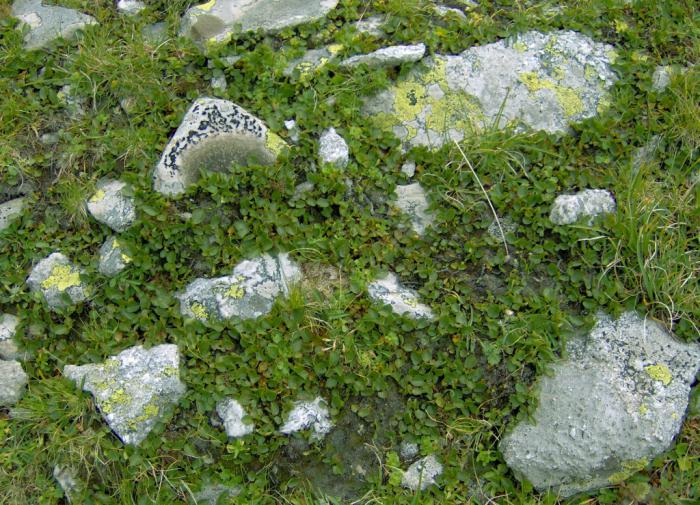
What are the features of the geographical position of the tundra in the summer? At this time of the year, you can spot edible mushrooms and a variety of delicious berries that stretch out in a colorful carpet, and you can also see herds of proud reindeer grazing. Thus, they look for their own food in the summer. Deer feed on everything they see: lichens, leaves of shrubs. In winter, they too will find food in the form
Unique flora
The organic world of the tundra is poor. The tundra-gley soils of this zone can hardly be called fertile, since they are completely frozen. Not all plants can survive in harsh northern conditions, where there is so little heat and sunlight. Best of all, lichens and mosses, polar poppy, black crow, princess, loidia late, swordweed sedge, saxifrage, snow buttercup and others have settled here. Such plants are an extraordinary delicacy for local wildlife. What other greens can you see in this area? About 300 species of flowering plants and almost 800 different species of lichens and mosses.

All plants are dwarf here. The so-called "forest" can reach you only up to the knee, and the "trees" will not be taller than the mushroom. The geographical position of the tundra is completely unsuitable for forests, and all because of the constant permafrost, which persists for many years in a row.
Animals of the tundra zone

On the steep rocky shores you can observe the noisy birds. Geographical position natural area the tundra is suitable for those animals who prefer the sea. A large amount of water is an excellent habitat for waterfowl: geese, ducks, loons. You can find passerines, waders, waterfowl, white geese, peregrine falcon, tundra partridge, lark. Here you will not find reptiles, but among the representatives of amphibians you can find frogs. Yet animal world rich in white hares, polar fox, weasels, foxes, wolves, polar and brown bears, musk oxen and, of course, reindeer. The tundra lakes are rich in a wide variety of fish - salmon, dallia.
Reindeer are another feature of arctic deserts
They are not only a feature, but also a symbol that the tundra zone is proud of. The geographical position for these animals is very convenient to inhabit. They exist not only in open windswept areas, but also on the islands of the Arctic Ocean. Moreover, these are the only ones from the family of ungulates that can exist here. We can observe large horns in both males and females. The main source of food for reindeer is tundra plants. These are lichens (lichen), buds, grass, small shoots of shrubs. In winter, they can extract plants from under the snow, while breaking it with their hooves.
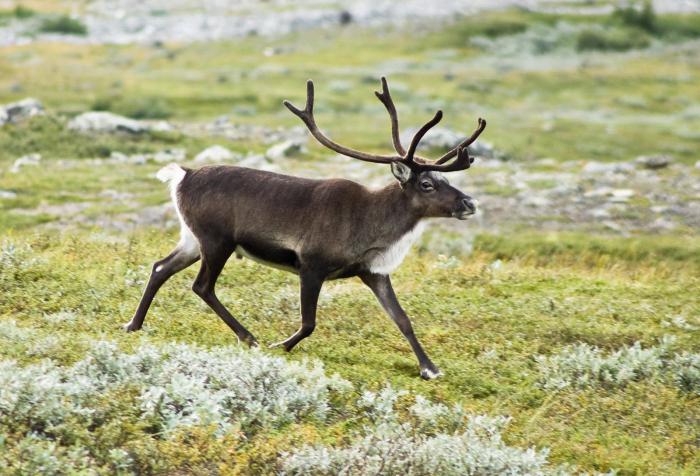
The coat of deer in winter is thick and long, the undercoat is well developed (to keep warm in severe frosts). In the summer, it becomes more rare and lighter. The summer color of deer is from grayish to brown. In winter, it is mostly white. The special structure of the hooves allows the reindeer to move successfully and quickly through swampy swamps and deep snow. These are gregarious and polygamous animals.
In winter, they move to places where extensive reindeer pastures are observed. One hundred or more kilometers from the habitat in the summer is not a problem for the winter migrations of deer. They shed no more than once a year. This animal is sensitive, has a great sense of smell, and also knows how to swim. Deer can freely swim across lakes and rivers.
How the components of nature in the tundra zone are interconnected
If we consider the geographical position of the tundra, it can be noted that forests begin in the southern part. This is how the forest-tundra originates. She stretched along the entire southern border tundra. It is already a little warmer here - in summer the temperature reaches 14 degrees Celsius. In the forest-tundra, a large amount of precipitation falls, which does not have time to evaporate. Thus, wetlands appear. The main food for the deep local rivers is melted snow. The first months of summer are the peak of high water. The geographical position of the tundra zone is gradually giving way to forest tundra.
Man began to explore the northern area long ago. Gradually, the landscape that stretches over more and more populated and transformed. Sea fishing is the main occupation of the northern peoples: the Chukchi and Eskimos. Hunting for local animals has established its own traditions of food and style of clothing. Meat of marine life, venison, fish, poultry are the main food products. Thanks to reindeer husbandry and hunting, the skins of fur and other animals are obtained, which are subsequently used as clothing.
How forest-tundra differs from tundra
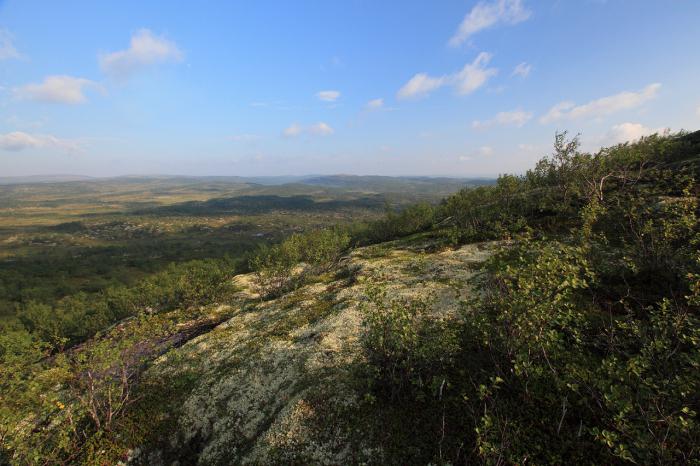
Forest-tundra is located in the zone between the tundra and taiga. More forest with tall trees can already be seen in the river valleys. This is how the geographical position of the tundra and forest-tundra differs. Here, between the rivers, you can find small islands of low trees covered with lichen. Summer is warmer and longer here. Due to the presence of trees, the wind speed is not felt as strongly here as in the tundra, where the area is completely open.
The removal of the forest-tundra from the ocean favors harsh winters with bitter frosts. Soils thaw much deeper, and permanent permafrost is observed only in some areas. The main food of the rivers is also melted snow.




